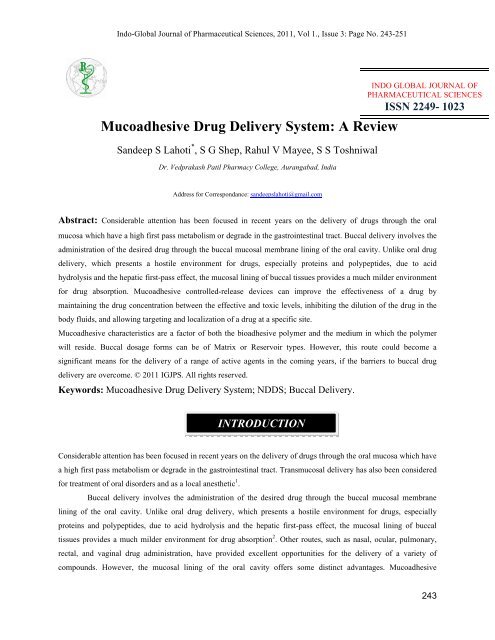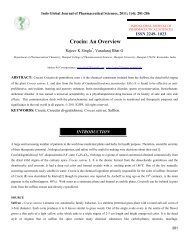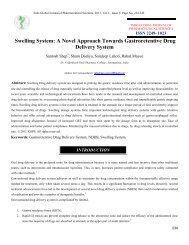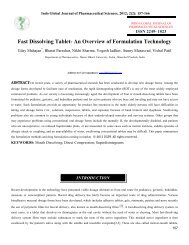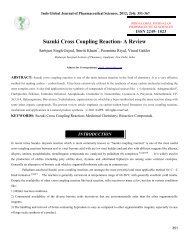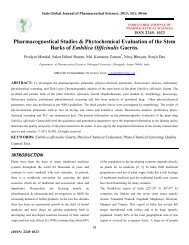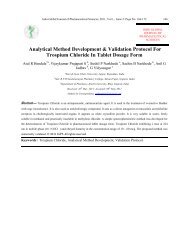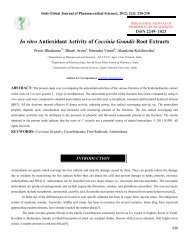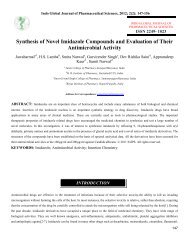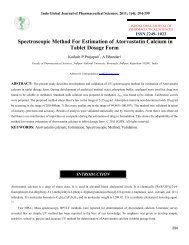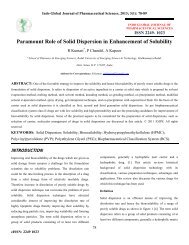Mucoadhesive Drug Delivery System - Indo Global Journal of ...
Mucoadhesive Drug Delivery System - Indo Global Journal of ...
Mucoadhesive Drug Delivery System - Indo Global Journal of ...
Create successful ePaper yourself
Turn your PDF publications into a flip-book with our unique Google optimized e-Paper software.
<strong>Indo</strong>-<strong>Global</strong> <strong>Journal</strong> <strong>of</strong> Pharmaceutical Sciences, 2011, Vol 1., Issue 3: Page No. 243-251Type I: A single layer device with multidirectional drug release. This type <strong>of</strong> dosage form suffers from significantdrug loss due to swallowing.Type II: An impermeable backing layer is superimposed on top <strong>of</strong> the drug-loaded bioadhesive layer, creating adouble-layered device and preventing drug loss from the top surface <strong>of</strong> the dosage form into the oral cavity.Type III: A unidirectional release device, from which drug loss is minimal, since the drug is released only from theside adjacent to the buccal mucosa. This can be achieved by coating every face <strong>of</strong> the dosage form, except the onethat is in contact with the buccal mucosa.Buccal tabletsTablets have been the most commonly investigated dosage form for buccal drug delivery to date. Buccal tablets aresmall, flat, and oval, with a diameter <strong>of</strong> approximately 5–8 mm 15 . Unlike conventional tablets, buccal mucoadhesivetablets allow for drinking and speaking without major discomfort. They s<strong>of</strong>ten, adhere to the mucosa, and areretained in position until dissolution and/or release is complete. These tablets can be applied to different sites in theoral cavity, including the palate, the mucosa lining the cheek, as well as between the lip and the gum. Successivetablets can be applied to alternate sides <strong>of</strong> the mouth. The major drawback <strong>of</strong> buccal bioadhesive tablets is their lack<strong>of</strong> physical flexibility, leading to poor patient compliance for long-term and repeated use.Buccal patchesPatches are laminates consisting <strong>of</strong> an impermeable backing layer, a drug-containing reservoir layer from which thedrug is released in a controlled manner, and a bioadhesive surface for mucosal attachment. Buccal patch systems aresimilar to those used in transdermal drug delivery. Two methods used to prepare adhesive patches include solventcasting and direct milling. In the solvent casting method, the intermediate sheet from which patches are punched isprepared by casting the solution <strong>of</strong> the drug and polymer(s) onto a backing layer sheet, and subsequently allowingthe solvent(s) to evaporate. In the direct milling method, formulation constituents are homogeneously mixed andcompressed to the desired thickness, and patches <strong>of</strong> predetermined size and shape are then cut or punched out. Animpermeable backing layer may also be applied to control the direction <strong>of</strong> drug release, prevent drug loss, andminimize deformation and disintegration <strong>of</strong> the device during the application period.Buccal filmsFilms are the most recently developed dosage form for buccal administration. Buccal films may be preferred overadhesive tablets in terms <strong>of</strong> flexibility and comfort. In addition, they can circumvent the relatively short residencetime <strong>of</strong> oral gels on the mucosa, which are easily washed away and removed by saliva. Moreover, in case <strong>of</strong> localdelivery for oral diseases, the films also help protect the wound surface, thus helping to reduce pain and treat thedisease more effectively. An ideal film should be flexible, elastic, and s<strong>of</strong>t, yet adequately strong to withstandbreakage due to stress from mouth movements. It must also possess good bioadhesive strength in order to beretained in the mouth for the desired duration <strong>of</strong> action. Swelling <strong>of</strong> film, if it occurs, should not be too extensive inorder to prevent discomfort.247
<strong>Indo</strong>-<strong>Global</strong> <strong>Journal</strong> <strong>of</strong> Pharmaceutical Sciences, 2011, Vol 1., Issue 3: Page No. 243-251For systemic delivery the relative impermeability <strong>of</strong> oral cavity mucosa with regard to drug absorption, especiallyfor large hydrophilic biopharmaceuticals, is a major concern.Toxicity and irritancy associated with buccal drug delivery 18Formulations that produce local damage at the site <strong>of</strong> application, such as ulceration <strong>of</strong> the mucosa, would precludetheir widespread usage as a result <strong>of</strong> the associated pain and discomfort. This is particularly important in buccal drugdelivery where the formulation is in contact with the mucosa for extended periods. Toxic effects can arise from thedrug itself, the bioadhesive or from other components <strong>of</strong> the formulation. For example, carbomers have beenreported to produce mucosal irritation believed to result from a localised low pH, whereas lectins have been shownto be cytotoxic. Excipients such as absorption enhancers (e.g., sodium dodecyl sulfate) have also been reported to beirritant.List <strong>of</strong> drugs delivered via buccal route 2,19In an effort to determine the feasibility <strong>of</strong> buccal route as a novel route <strong>of</strong> drug delivery, several drugs (Table 2)have been studied. The variation in class <strong>of</strong> compounds illustrates that the pharmaceutical industries have analternative and novel routes <strong>of</strong> administration for existing drugs.2, 19List <strong>of</strong> Active Ingredients delivered via a buccal routeSr. No. Active Ingredients Sr. No. Active Ingredients1. Acitretin 25 Metronidazole2 Acyclovir 26 Melatonin3 Arecoline 27 Metoprolol tartrate4 Buprenorpine 28 Morphine sulphate5 Carbamazepine 29 Nalbuphine6 Cetyl Pyridinium chloride 30 Nicotine7 Chlorhexidine diacetate 31 Nifedipine8 Chitosan 32 Omeprazole9 Chlorpheniramine maleate 33 Oxytocin10 Cyanocobalamin 34 Pentazocine11 Danazol 35 Protirelin249
<strong>Indo</strong>-<strong>Global</strong> <strong>Journal</strong> <strong>of</strong> Pharmaceutical Sciences, 2011, Vol 1., Issue 3: Page No. 243-25112 Denbufylline 36 Pindolol13 Dicl<strong>of</strong>enac sodium 37 Piroxicam14 Diltiazem Hydrochloride 38 Propranolol15 Ergotamine tartrate 39 Propolis16 Fluride 40 Recombinant human epidermal growth factor (Rh EFG)17 Flurbipr<strong>of</strong>en 41 Salmon calcitonin18 Glucagon-like peptide (GLP)-1 42 Sodium fluoride19 Hydrocortisone acetate 43 Testosterone20 Insulin 44 Terbutaline sulphate21 Lact<strong>of</strong>errin 45 Theophylline22 Lignocaine 46 Thyotropin releasing hormone23 Leu-enkephalin 47 Triamcinolone acetate24 Luteinizing hormone releasing Hormone (LHRH) 48 Zinc sulphateREFERENCES1) DeVries M, Bodde H, Verhoef J, Junginger H. Developments in Buccal <strong>Drug</strong> <strong>Delivery</strong>.Critical Reviews in Therapeutic <strong>Drug</strong> <strong>Delivery</strong><strong>System</strong>s.CRC Press Inc, 8(3), 1991, 271-303.2) Miller N, Chittchang M, Johnston T. The use <strong>of</strong> mucoadhesive polymers in buccal drug delivery. Advanced <strong>Drug</strong> <strong>Delivery</strong> Reviews. 57(2005) 1666– 1691.3) Huang Y, Leobandung W, Foss A, Peppas N. Molecular aspects <strong>of</strong> muco- and bioadhesion:Tethered structures and site-specific surfaces.<strong>Journal</strong> <strong>of</strong> cont. Release.65, 1-2, 2000, 63-71.4) Shojaei A. Buccal Mucosa As A Route For <strong>System</strong>ic <strong>Drug</strong> <strong>Delivery</strong>. <strong>Journal</strong> <strong>of</strong> Pharmacy and Pharmaceutical Sciences. 1(1), 1998, 15-30.5) Jasti B, Xiaoling L, Gary C. Recent Advances in <strong>Mucoadhesive</strong> <strong>Drug</strong> <strong>Delivery</strong> <strong>System</strong>s. Bussiness Briefing: Pharmtech. 2004, 194-196.6) Chen J, Cyr G. Compositions producing adhesion through hydration. In:R.S. Manly, Editor, Adhesion in Biological <strong>System</strong>s. AcademicPress, New York. (1970), 163–180.7) Gu J, Robinson J, Leung S. Binding <strong>of</strong> acrylic polymers to mucin/epithelial surfaces:structure–property relationships. Crit. Rev. Ther. <strong>Drug</strong>Carr. Syst. 5 (1998), 21–67.8) Park H, Robinson J. Mechanisms <strong>of</strong> mucoadhesion <strong>of</strong> poly (acrylic acid) hydrogels. Pharm. Res. 4 (1987), 457–464.9) Lehr C, Bouwstra J, Schacht E, Junginger H. In vitro evaluation <strong>of</strong> mucoadhesive properties <strong>of</strong> chitosan and some other natural polymers.Int. J. Pharm. 78 (1992), 43–48.10) Peppas N,Buri P. Surface,interfacial and molecular aspects <strong>of</strong> polymer bioadhesion on s<strong>of</strong>t tissues. J. Control. Release. 2 (1985), 257–275.250
<strong>Indo</strong>-<strong>Global</strong> <strong>Journal</strong> <strong>of</strong> Pharmaceutical Sciences, 2011, Vol 1., Issue 3: Page No. 243-25111) Rathbone M, Drummond B, Tucker I. The oral cavity as a site for systemic drug delivery. Adv. <strong>Drug</strong> Del. Rev. 13 (1994), 1–22.12) Ho N, Barsuhn C, Burton P, Merkle H. Routes <strong>of</strong> delivery: case studies. (3) Mechanistic insights to buccal delivery <strong>of</strong> proteinaceoussubstances. Adv. <strong>Drug</strong> Del. Rev. 8 (1992), 197–235.13) Mitra A, Alur H, Johnston A. Peptides and Protein- Buccal Absorption, Encyclopedia <strong>of</strong> Pharmaceutical technolog.Marcel DekkerInc.2002, Edition 2081-2093.14) Van Roey J, Haxaire M, Kamya M, Lwanga I. Katabira E. Comparative efficacy <strong>of</strong> topical therapy with a slow-release mucoadhesivebuccal tablet containing miconazole nitrate versus systemic therapy with ketoconazole in HIV-positive patients with oropharyngealcandidiasis. J. Acquir. Immune Defic. Syndr. 35 (2004), 144–150.15) Rathbone M, Drummond B, Tucker I. The oral cavity as a site for systemic drug delivery. Adv. <strong>Drug</strong> Del. Rev. 13 (1994), 1–22.16) Miller S, Donovan M. Effect <strong>of</strong> poloxamer 407 gel on the miotic activity <strong>of</strong> pilocarpine nitrate in rabbits. Int. J. Pharm. 12 (1982), 147–152.17) Lalla J, Gurnancy R. Polymers for mucosal <strong>Delivery</strong>-Swelling and <strong>Mucoadhesive</strong> Evaluation. Indian <strong>Drug</strong>s. 2002, 39(5).18) Smart J. Buccal drug delivery. Expert Opinion <strong>Drug</strong> <strong>Delivery</strong>.May 2005, 2(3), 507-517.251


